基于特征模式的共振模型,用于分析和设计可重构的频率选择性表面
IF 2
3区 计算机科学
Q3 ENGINEERING, ELECTRICAL & ELECTRONIC
IEEE Transactions on Electromagnetic Compatibility
Pub Date : 2024-11-11
DOI:10.1109/TEMC.2024.3486544
引用次数: 0
摘要
建立了一种新的共振模型,利用特征模态(CMs)来评价频率选择表面(fss)的共振特性。这种基于cm的共振模型源自Poynting定理,通过将二极管等效电路集成到矩量法的阻抗矩阵中,扩展了其应用范围,以适应可重构的频率选择表面(rfss)。该模型不仅为CMs提供了明确的物理解释,而且通过富有洞察力的现场视角增强了fss的分析和设计过程。为了说明所提出的基于cm的共振模型,我们使用两种类型的偶极子结构举例说明带阻和带通特性,其中使用子结构阻抗矩阵变换来解释元件间耦合。通过综合全波仿真结果验证了该模型的有效性。然后,利用所建立的模型进一步设计了一种单层三带RFSS。制作了原型并进行了测量,结果表明模拟结果与实验结果吻合良好。所提出的谐振模型在指导RFSS设计方面的有效性被证实,有望在电磁干扰屏蔽方面得到潜在的应用。本文章由计算机程序翻译,如有差异,请以英文原文为准。
Characteristic Mode-Based Resonance Model for Analyzing and Designing Reconfigurable Frequency-Selective Surfaces
A novel resonance model is formulated to evaluate the resonance properties of frequency-selective surfaces (FSSs) using characteristic modes (CMs). This CM-based resonance model, derived from the Poynting theorem, extends its application to accommodate reconfigurable frequency-selective surfaces (RFSSs) by integrating the equivalent circuit of diodes into the impedance matrix of the method of moments. The model not only provides a well-defined physical interpretation with the CMs but also enhances the analysis and design process of FSSs through insightful field perspectives. To illustrate the proposed CM-based resonance model, we exemplify band-stop and band-pass properties using two types of dipole structures, where the substructure impedance matrix transformation is used to account for the interelements coupling. The model is validated through comprehensive full-wave simulation results. Next, a single-layer triband RFSS is further designed with the aid of the formulated model. Prototypes are fabricated and subjected to measurements, revealing good agreement between simulations and experimental results. The confirmed usefulness in guiding the RFSS design of the proposed resonance model is expected to be of potential application in EMI shielding.
求助全文
通过发布文献求助,成功后即可免费获取论文全文。
去求助
来源期刊
CiteScore
4.80
自引率
19.00%
发文量
235
审稿时长
2.3 months
期刊介绍:
IEEE Transactions on Electromagnetic Compatibility publishes original and significant contributions related to all disciplines of electromagnetic compatibility (EMC) and relevant methods to predict, assess and prevent electromagnetic interference (EMI) and increase device/product immunity. The scope of the publication includes, but is not limited to Electromagnetic Environments; Interference Control; EMC and EMI Modeling; High Power Electromagnetics; EMC Standards, Methods of EMC Measurements; Computational Electromagnetics and Signal and Power Integrity, as applied or directly related to Electromagnetic Compatibility problems; Transmission Lines; Electrostatic Discharge and Lightning Effects; EMC in Wireless and Optical Technologies; EMC in Printed Circuit Board and System Design.

 求助内容:
求助内容: 应助结果提醒方式:
应助结果提醒方式:


